C 6.18. Micro-biological damage, mould, grazing
C6 damage sub-categories:
C 6.1. Rust accretion, foxing
C 6.2. Glass-like layers
C 6.3. Stains, accretion
C 6.3.1. Handling marks
C 6.3.2. Ink stains
C 6.4. Ink corrosion
C 6.5. Ink loss; fading
C 6.6. Offset
C 6.7. Ink flake off; detachment of the parchment
C 6.8. Tears, splits
C 6.9. Pleats
C 6.10. Cockling
C 6.11. Curling
C 6.12. Pleats, double folds
C 6.13. Folds
C 6.14. Contraction, shrinkage
C 6.15. Internal loss
C 6.16. Edge loss
C 6.17. Blooms; calcite deposits
C 6.18. Micro-biological damage, mould, grazing
C 6.19. Brittleness
C 6.20. Rigidity, stiffness
Micro-biological damage is a general term used to describe the effects of bacteria, mould and pests (e.g. rodents, insects)
Mould is biological damage in the form of pigmentation splotches and softened areas.
Damage to a surface mechanically damaged by pests is defined as grazing. Biological damage can easily be identified visually, as it significantly changes the relief and appearance of the parchment surface. The damage is distinguished by grey, reddish-pink and other colour splotches on the surface. Damage makes the parchment fragile, thins the material and causes significant damage to the ink lettering.
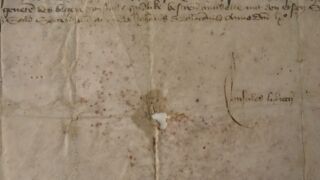
Ürik TLA.230.1.BB_40/ii
Rabe.
Pärgamendi füüsilise tugevuse vähenemise tulemusena on pärgament raskesti käsitletav
Hapraks muutunud pärgament. Bioloogilised kahjustused on sagedaks põhjuseks pärgamendi hapraks muutmisel.

Ürik EAA.854.2.282 1668. a.
Ürik TLA.230.1.BB_74/iii
Bioloogilised kahjustused. Hallitanud. Näritud pind.
Tugev bioloogiline kahjustus pärgamendi alumises välisservas, muudab oluliselt üriku välisilmet ja muudab materjali hapraks. Dokumenteeritud kaldvalguses.

Ürik EAA.957.1, 1553. a.
Bioloogilised kahjustused. Hallitanud. Näritud pind.
Degradeerunud ja bioloogiliselt tugt kahjustunud pärgament kaldvalguses.

Ürik TLA.230.1.BB_40/ii
Bioloogilised kahjustused. Hallitanud. Näritud pind.
Bioloogilise kahjustuse tulemusena lokaalselt õhenenud ja auklikuks muutunud pärgament läbivas valguses.

Ürik TLA.230.1.BB_40/vi
Bioloogilised kahjustused. Hallitanud. Näritud pind.
Bioloogilise kahjustuse tulemusena lokaalselt õhenenud pärgament kaldvalguses.

Ürik TLA.230.1.BB_40/vi
Bioloogilised kahjustused. Hallitanud. Näritud pind.
Bioloogilise kahjustuse tulemusena auklikuks muutunud pärgament kaldvalguses.
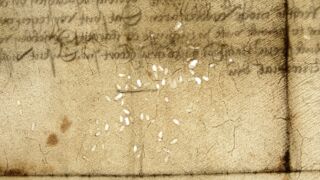
Ürik TLA.230.1.BB_40/vi
Bioloogilised kahjustused. Hallitanud. Näritud pind.
Bioloogilise kahjustuse tulemusena auklikuks muutunud pärgament läbivas valguses.
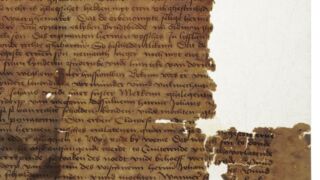
Ürik TLA.230.1.bb_74/i.38, 1491. a.
Bioloogilised kahjustused. Hallitanud. Näritud pind.
Hapraks muutunud pärgamendi servades on tekkinud suured materjalikaod. Kahjustus on dokumenteeritud läbivas valguses.

Ürik TLA.230.1.BB_74/iii
Bioloogilised kahjustused. Hallitanud. Näritud pind.
Dokumendi tagumise poole kahjustus on dokumenteeritud kaldvalguses. Lokaalsed bioloogilised kahjustused on muutnud pärgamendi õhemaks ja auklikuks.
![[:et]Ürik TLA.230.1.BB_74/iii
Bioloogiline kahjustus. Hallitanud. Näritud pind.
Bioloogilise kahjustumise tulemusena toimuv lokaalne pärgamendi õhenemine. Kahjustus on dokumenteeritud kaldvalguses.[:]](http://pergament.ee/wp-content/uploads/cache/remote/pergament-ee/5800575.jpg)
[:et]Ürik TLA.230.1.BB_74/iii
Bioloogiline kahjustus. Hallitanud. Näritud pind.
Bioloogilise kahjustumise tulemusena toimuv lokaalne pärgamendi õhenemine. Kahjustus on dokumenteeritud kaldvalguses.[:]
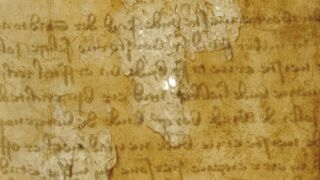
Ürik TLA.230.1.BB_74/iii
Bioloogilised kahjustused. Hallitanud. Näritud pind.
Bioloogilise kahjustumise tulemusena toimuv lokaalne pärgamendi õhenemine. Dokumendi tagumise poole kahjustus on dokumenteeritud läbivas valguses.
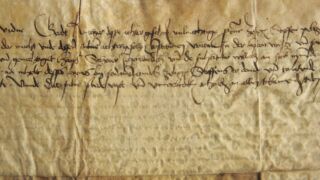
Ürik TLA.230.1.BB_74/iii
Bioloogilised kahjustused. Hallitanud. Näritud pind.
Bioloogilise kahjustuse tulemusena toimuv ebaühtlane pärgamendi õhenemine üle pinna võib omakorda põhjustada deformatsiooni
![[:et]Ürik 230.1.BB_74/iv
Bioloogilised kahjustused. Hallitanud. Näritud pind.
Bioloogilised kahjustused muudavad pärgamendi omadusi, pinna reljeefi ja värvust.[:]](http://pergament.ee/wp-content/uploads/cache/remote/pergament-ee/328375242.jpg)
[:et]Ürik 230.1.BB_74/iv
Bioloogilised kahjustused. Hallitanud. Näritud pind.
Bioloogilised kahjustused muudavad pärgamendi omadusi, pinna reljeefi ja värvust.[:]
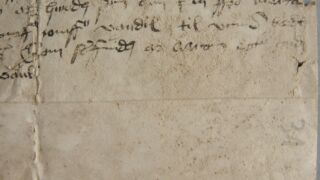
Ürik TLA.230.1.bc_36/b, 1492. a.
Bioloogilised kahjustused. Hallitanud. Näritud pind.
Bioloogilise kahjustuse tulemusena toimuv pinna irdumine põhjustab omakorda tindi kihiti eraldumise, mahakoorumise.
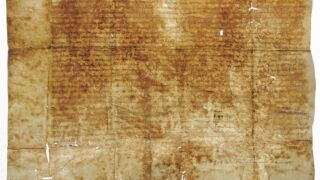
TLA.230.1.BE_2/v
Bioloogilised kahjustused. Hallitanud. Näritud pind.
Tugeva bioloogilise kahjustusega pärgamendi puhul võib pärgamendi õhenemine muuta pärgamendi hapraks ja raskesti käsitletavaks. Dokumenteeritud läbivas valguses.
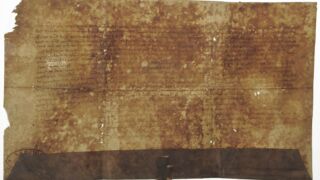
Ürik TLA.230.1-i.851/a, 1496. a.
Bioloogilised kahjustused. Hallitanud. Näritud pind.
Tugeva bioloogilise kahjustuse tulemusena võib pärgament lokaalselt õheneda. Pärgamendi õhenemine on hästi nähtav läbivas valguses.
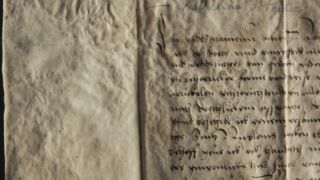
Ürik TLA.230.1-iiib.88, 1533. a.
Bioloogilised kahjustused. Hallitanud. Näritud pind.
Tugev bioloogiline kahjustus üle kogu pinna. Kahjustuste tulemusena muutuvad oluliselt pärgamendi omadused, pinna reljeef ja värvus.
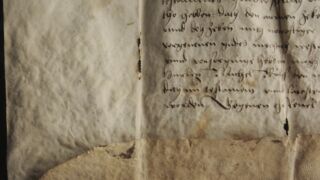
Ürik TLA.230.1-iiib.88, 1533. a.
Bioloogilised kahjustused. Hallitanud. Näritud pind.
Tugt degradeerunud, hallitanud, näritud pärgament. Kahjustused on tugt muutnud pärgamendi pinna reljeefi ja värvust. Bioloogiliste kahjustuste tulemusena on pärgament üle pinna ebaühtlaselt õhenenud.
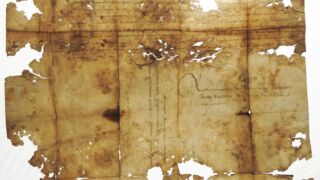
Ürik TLA.230.1.BE_14/v
Rabe, habras.
Bioloogilise kahjustuse tulemusena lõhenenud, hapraks muutunud ja raskesti käsitletav pärgament läbivas valguses.
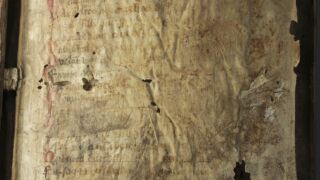
Ürik TLA.230.1.cm4, 13. saj.
Rabe, habras.
Keskaegse ahelköite esilehe bioloogilised kahjustused on selle muutnud hapraks.
Pärgamendi füüsilise tugevuse vähenemise tulemusena on pärgament raskesti käsitletav.
